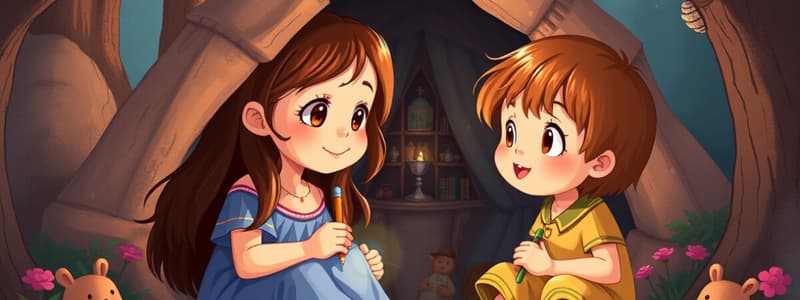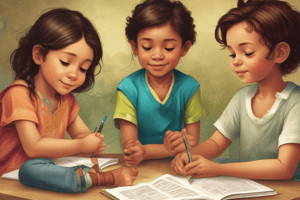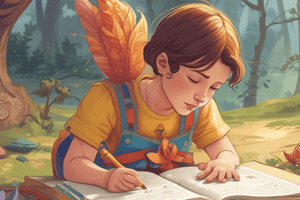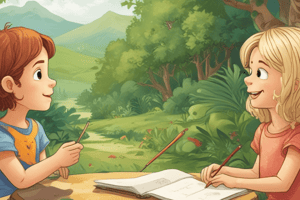Podcast
Questions and Answers
What defines alphabetic awareness in early literacy?
What defines alphabetic awareness in early literacy?
- Understanding the meaning of words in context
- Ability to recognize letters and translate them to sounds (correct)
- Ability to write words correctly
- Fluency in reading with speed and accuracy
Which of the following best describes print awareness?
Which of the following best describes print awareness?
- Recognizing sounds in spoken language
- Knowing how to read from back to front
- The ability to write stories and poems
- Understanding the organization and meaning of text (correct)
What is a primary component of reading comprehension?
What is a primary component of reading comprehension?
- Being able to identify all letters of the alphabet
- The speed at which a person reads aloud
- The ability to memorize text for later recitation
- Simultaneously extracting and constructing meaning from written language (correct)
Which skill is essential for phonological awareness?
Which skill is essential for phonological awareness?
What is an example of a literacy-rich environment?
What is an example of a literacy-rich environment?
Which of the following materials would NOT typically be found in a literacy-rich environment?
Which of the following materials would NOT typically be found in a literacy-rich environment?
Oral language in early literacy emphasizes which of the following skills?
Oral language in early literacy emphasizes which of the following skills?
Which activity would best support the development of written language skills?
Which activity would best support the development of written language skills?
What is the primary purpose of using the same types of materials in different activities?
What is the primary purpose of using the same types of materials in different activities?
Which component is NOT typically part of a literacy-rich environment?
Which component is NOT typically part of a literacy-rich environment?
How do literacy-rich environments benefit children?
How do literacy-rich environments benefit children?
Which of the following is an example of a literacy-rich learning center in a classroom?
Which of the following is an example of a literacy-rich learning center in a classroom?
What is a key characteristic of literacy-rich environments?
What is a key characteristic of literacy-rich environments?
Which of the following is NOT a learning center mentioned for literacy learning?
Which of the following is NOT a learning center mentioned for literacy learning?
In addition to physical materials, what is crucial for promoting literacy in children?
In addition to physical materials, what is crucial for promoting literacy in children?
What should literacy-rich environments provide to children?
What should literacy-rich environments provide to children?
What is the primary purpose of identifying developmental milestones in children?
What is the primary purpose of identifying developmental milestones in children?
At what age can most children typically count up to 10 things?
At what age can most children typically count up to 10 things?
Which of the following cognitive skills is a child likely to develop by age 3?
Which of the following cognitive skills is a child likely to develop by age 3?
What emotional development skill is typically seen in a 4-year-old child?
What emotional development skill is typically seen in a 4-year-old child?
By age 5, which language skill is expected from a child?
By age 5, which language skill is expected from a child?
What is a typical movement skill for a 4-year-old child?
What is a typical movement skill for a 4-year-old child?
At what age can a child typically start to understand terms like 'mine' and 'yours'?
At what age can a child typically start to understand terms like 'mine' and 'yours'?
Which social skill is commonly exhibited by a 3-year-old?
Which social skill is commonly exhibited by a 3-year-old?
Which of the following skills is typical for a 5-year-old regarding play?
Which of the following skills is typical for a 5-year-old regarding play?
What type of literature is most suitable for young children's development?
What type of literature is most suitable for young children's development?
What is one sign of cognitive development in children aged 4 years?
What is one sign of cognitive development in children aged 4 years?
What fine motor skill is a 5-year-old likely to be developing?
What fine motor skill is a 5-year-old likely to be developing?
Which characteristic is typically found in a child with strong emotional development at age 3?
Which characteristic is typically found in a child with strong emotional development at age 3?
Flashcards are hidden until you start studying
Study Notes
Learning Objectives
- Preservice teachers (PST) will articulate their reading identity.
- PST will understand how to utilize children’s literature effectively to cater to developmental characteristics and needs of young children.
Developmental Milestones
- Milestones indicate skills children are expected to achieve by specific ages.
- Skill development order is relatively consistent, but timing varies among individuals.
Development Table (Ages 3-5)
Cognitive Development
- 3 years: Assembles 3-4 piece puzzles, engages with interactive toys, can turn door knobs and pages of books.
- 4 years: Counts objects, draws simple stick figures, plays board games, identifies some colors and numbers.
- 5 years: Counts up to 10, accurately copies letters and shapes, comprehends simple story sequences.
Social and Emotional Development
- 3 years: Shows empathy, understands concepts of possession ("mine" vs "yours"), and can dress independently.
- 4 years: Participates in role-play, discusses likes/dislikes, and engages in simple pretend play.
- 5 years: Recognizes gender roles, socializes with peers, and distinguishes between reality and imagination.
Language Development
- 3 years: Constructs sentences with 2-3 words, begins to share daily experiences verbally.
- 4 years: Tells stories, shows understanding of rhymes and basic spatial relationships.
- 5 years: Recites nursery rhymes, can respond to questions about stories, names letters.
Movement/Physical Development
- 3 years: Walks up/down stairs, runs and jumps confidently, catches a ball.
- 4 years: Hops, uses scissors, begins to walk backward.
- 5 years: Can perform tasks like somersaults, swings independently, and manages some self-care routines.
Six Domains of Preliteracy Development
- Alphabetic Awareness: Recognizing letters and understanding their sound connections.
- Print Awareness: Understanding the function and arrangement of text, recognizing that print carries meaning.
- Written Language: Representing ideas through writing, distinguishing elements like letters and words.
- Comprehension: Processing and understanding meaning from texts and spoken language.
- Phonological Awareness: Manipulating sounds in words and recognizing sound patterns.
- Oral Language: Using language effectively for communication and deeper understanding.
Characteristics of a Literacy-Rich Environment
- Engaging spaces with various literacy materials.
- Comfort and accessibility for young children.
Materials in a Literacy-Rich Environment
- Print Materials: Calendars, job charts, menus, alphabet toys, and signs.
- Reading Materials: Books, magazines, flyers, and recipes.
- Writing Materials: Pencils, markers, crayons, and easels.
- Electronic Materials: Audiobooks, DVDs, and computers.
Utilizing Materials Across Activities
- Materials should be used in multiple contexts to enhance learning and skill application, e.g., dry-erase boards for lists and writing practice.
Components of Literacy-Rich Environments
- Should include a variety of print, reading, and writing resources.
- Designated areas for early literacy experiences.
- Adults modeling practical uses of reading and writing.
Classroom Environments
- Diverse indoor learning centers: reading and writing centers, dramatic play, music, art, and educational resources.
- Outdoor opportunities: climbing structures, sandbox play, and community exploration.
Studying That Suits You
Use AI to generate personalized quizzes and flashcards to suit your learning preferences.




